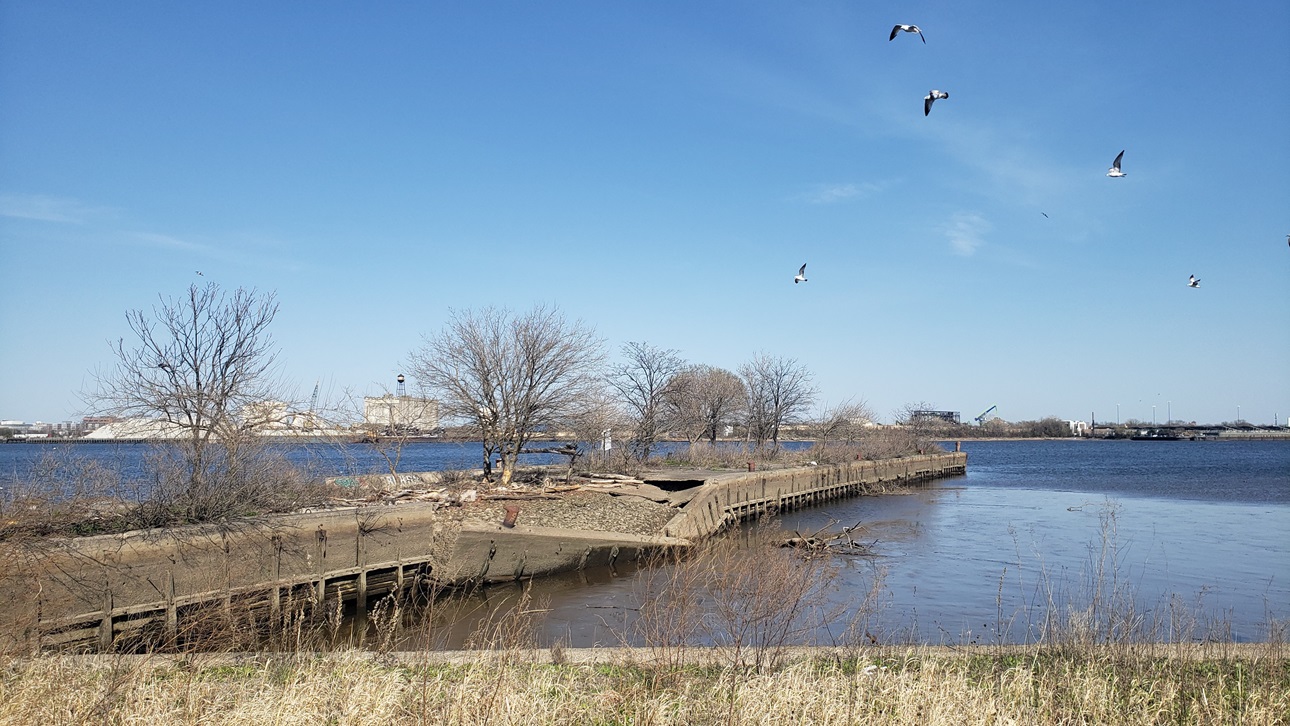Philadelphia, PA vASP: Washington Avenue Waterfront Piers & District

A Resilient Land Use Cohort (RLUC) Virtual Advisory Services Panel
Background and Assignment:
Ten years after the city of Philadelphia’s adoption of the Master Plan for the Central Delaware (the Master Plan), the Delaware River Waterfront Corporation (DRWC) has made significant progress implementing the vision of the plan. The central and northern end of the riverfront has been the location of much of this development, with private investments leveraging new public spaces and assets, and the DRWC has ensured that public access is introduced along the entire formerly industrial and privately held waterfront. However, the Master Plan did not articulate a detailed redevelopment strategy for the abandoned and deteriorating maritime piers along the waterfront and did not anticipate the complexity of ownership and stewardship challenges of these once heroic elements of maritime infrastructure.
DRWC asked ULI to convene a three-and-a-half-day vASP to focus on the redevelopment and reinvestment of the study area along the southern reach of the Delaware River in Philadelphia and to assist the organization with strategies to ensure that the future riverfront is not only active and vibrant, but also resilient to the imminent impacts of sea-level rise on the waterfront properties.
Key Recommendations:
- Create a comprehensive infrastructure plan to bring DRWC and private owners into consensus about sea-level rise, coastal inundation, flooding and infrastructure design assumptions.
- Immediately create a formal association of existing private landowners, similar to a business improvement district (BID), to foster partnership and coordination across public and private sectors.
- DRWC should continue to acquire abandoned piers and shorelines for the purpose of establishing unprecedented public access to the formerly industrial waterfront. -- Quantify how resilient coastal infrastructure creates value for adjacent parcels of developable land.
- Aggressively position the entire endeavor as eligible for resilient infrastructure funding from federal, state, city and philanthropic sources.
- Explore the use of land value capture mechanisms with the City of Philadelphia in order to facilitate the creation of Philadelphia’s newest mixed-use waterfront neighborhood and civic destination.
The Philadelphia virtual Advisory Services panel is part of a larger series of resilience technical assistance and learning opportunities, called the Resilient Land Use Cohort (RLUC). The RLUC is a network of ULI District Councils, member experts and community partners in seven cities working together to identify strategies to be more resilient in the face of climate change and other vulnerabilities, including floods, extreme storms, drought, wildfire, and extreme heat, as well as the related social, environmental, and economic impacts. Funding for this engagement and the cohort is provided by the ULI Foundation with support from JPMorgan Chase.
Report Summary: Background and Assignment:
Ten years after the city of Philadelphia’s adoption of the Master Plan for the Central Delaware (the Master Plan), the Delaware River Waterfront Corporation (DRWC) has made significant progress implementing the vision of the plan. The central and northern end of the riverfront has been the location of much of this development, with private investments leveraging new public spaces and assets, and the DRWC has ensured that public access is introduced along the entire formerly industrial and privately held waterfront. However, the Master Plan did not articulate a detailed redevelopment strategy for the abandoned and deteriorating maritime piers along the waterfront and did not anticipate the complexity of ownership and stewardship challenges of these once heroic elements of maritime infrastructure.
DRWC asked ULI to convene a three-and-a-half-day vASP to focus on the redevelopment and reinvestment of the study area along the southern reach of the Delaware River in Philadelphia and to assist the organization with strategies to ensure that the future riverfront is not only active and vibrant, but also resilient to the imminent impacts of sea-level rise on the waterfront properties.
Key Recommendations:
- Create a comprehensive infrastructure plan to bring DRWC and private owners into consensus about sea-level rise, coastal inundation, flooding and infrastructure design assumptions.
- Immediately create a formal association of existing private landowners, similar to a business improvement district (BID), to foster partnership and coordination across public and private sectors.
- DRWC should continue to acquire abandoned piers and shorelines for the purpose of establishing unprecedented public access to the formerly industrial waterfront. -- Quantify how resilient coastal infrastructure creates value for adjacent parcels of developable land.
- Aggressively position the entire endeavor as eligible for resilient infrastructure funding from federal, state, city and philanthropic sources.
- Explore the use of land value capture mechanisms with the City of Philadelphia in order to facilitate the creation of Philadelphia’s newest mixed-use waterfront neighborhood and civic destination.
The Philadelphia virtual Advisory Services panel is part of a larger series of resilience technical assistance and learning opportunities, called the Resilient Land Use Cohort (RLUC). The RLUC is a network of ULI District Councils, member experts and community partners in seven cities working together to identify strategies to be more resilient in the face of climate change and other vulnerabilities, including floods, extreme storms, drought, wildfire, and extreme heat, as well as the related social, environmental, and economic impacts. Funding for this engagement and the cohort is provided by the ULI Foundation with support from JPMorgan Chase.


